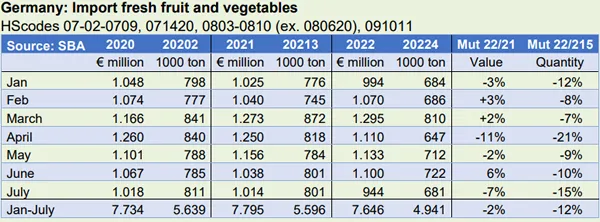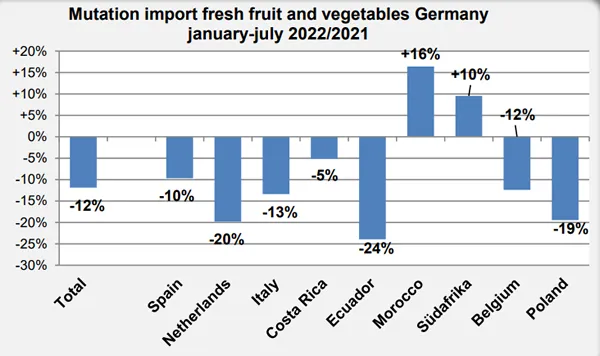In July, German fresh fruit and vegetable imports fell well short of those in the same month last year. In July 2022, imports reached 681,000 tons compared to 801,000 tons in July 2021. That is a drop of 15% or 120,000 tons. With that, the lesser imports in July were even more substantial than in the year's first half.
Over the first seven months of this year, Germany imported 12% fewer fresh fruits and vegetables than in 2021's first seven months. The negative difference was slightly larger than the same period in 2020. In value terms, this July's imports were worth less than in July last year, €7.65 billion versus €7.80 billion.
The first seven months of 2022's average import price was, however, ten percent higher than during the same time last year, shows a Fruit & Vegetable Facts analysis.

In July, 10% less from the Netherlands, in the first seven months, even 20% less
In this year's first seven months, Germany imported fewer fruits and vegetables from all five of its top suppliers. Spain is their largest supplier, by far, but delivered ten percent less, the Netherlands as much as 20% less, and Italy 13% less. Imports from Costa Rica lagged "only" five percent, while those from Ecuador plummeted by 24%. Still, some countries supplied Germany with more fresh fruits and vegetables in 2022's first seven months.
These include Morocco +16%, South Africa +10%, Peru +8% and Portugal +16%. Incidentally, German imports from South Africa and Peru are mostly re-exports via the Netherlands. The figures presented in this analysis are sourced from the German Federal Statistical Office (SBA), which uses the production country. That is in contrast to Eurostat, which uses the country of origin ("last port").

Less imported of just about everything
German imports of all the important products fell during the first seven months of this year, including July. Bananas are Germany's top fresh fruit and vegetable import product. In July, these imports decreased by 12%, and over 2022's first seven months, there was a nine percent decline.
For tomatoes, it was -12% for July and -16% for January-July. For cucumbers, it was respectively -28% and -14%, for apples -12% and -13%, and for bell peppers -15% and -7%. There are exceptions to this seven-month downward trend: grapes (+6%), melons (+20%), avocados (+2%), cauliflower/broccoli (+14%), and blueberries (+3%).

Click here for the background figures.
For more information:
Jan Kees Boon
Fruit and Vegetable Facts
Website: www.fruitandvegetablefacts.com
Email: fruitvegfacts@gmail.com
